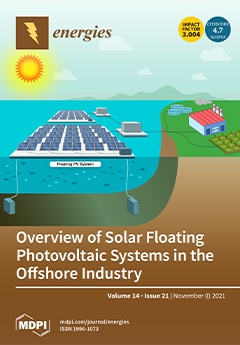This paper puts forward a methodology for calculating the duration and energy efficiency of regimes for autoclave steaming of wooden prisms for veneer production at limited heat power of the steam generator, depending on the dimensions of the prism’s cross section, wood moisture content, and loading level of the autoclave. The methodology is based on the use of two personal mathematical models: the 2D non-linear model of the temperature distribution in non-frozen wooden prisms subjected to steaming and subsequent conditioning in an air medium, and the model of the non-stationary heat balance of autoclaves for steaming wood materials. Using the suggested methodology, the calculation and research into the duration and energy efficiency of regimes for heating of beech prisms have been carried out. The variables used were an initial temperature of 0 °C, cross-section dimensions 0.3 × 0.3 m, 0.4 × 0.4 m, and 0.5 × 0.5 m, moisture content of 0.4, 0.6, and 0.8 kg·kg
−1, during their steaming in an autoclave with a diameter of 2.4 m, length of 9.0 m and loading level of 40, 50, and 60% at a limited heat power of the steam generator, equal to 500 kW. It has been determined that the duration of the autoclave steaming regimes, at a loading level of 50% being most often used in the practice beech prisms with moisture of 0.6 kg·kg
−1, does not exceed 9 h, 13 h, and 20 h for prisms with cross-section 0.3 × 0.3 m, 0.4 × 0.4 m, and 0.5 × 0.5 m, respectively. This duration is less than half of the corresponding duration of the steaming regimes at atmospheric pressure. The energy needed for warming up such prisms themselves does not exceed 60, 65, and 69 kWh·m
−3, respectively, and the energy consumption of the whole autoclave then is equal to about 90, 99, and 105 kWh·m
−3, respectively. The energy efficiency of the autoclave steaming regimes changes between 62.2% and 68.8% for the studied ranges of the influencing factors and it turns out to be more than 2–3 times larger in comparison with the efficiency of the steaming at atmospheric pressure. The methodology can be used for various calculations with ANSYS and to create the software for systems used for computing and model-based automatic realization of energy-efficient regimes for autoclave steaming of different wood materials from various species. This could be useful in developing similar methodologies in different areas of thermal treatment at increased pressure of various capillary-porous materials of plant or technical origin.
Full article





